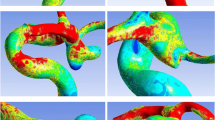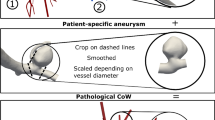Abstract
Purpose
Despite numerous studies addressing the rupture risk of intracranial aneurysms that have been published, the assessment thereof still remains challenging. Image-based simulations enable a precise prediction of patient-specific blood flow information. However, those approaches normally consider only small segments of the complete cerebral vasculature.
Methods
To test the validity of the consideration of single aneurysms in one computational setup, domains of the complete anterior and posterior circulations with multiple intracranial aneurysms (MIA) were simulated. Six patients with MIA were investigated, while 3D surfaces of eleven unruptured and six ruptured aneurysms were segmented. The segmentations were used for the determination of morphological parameters and also for image-based blood flow simulations used to characterize the hemodynamic properties of each aneurysm.
Results
In the geometric comparison, neck aspect ratios of unruptured and ruptured aneurysms did not differ significantly. In contrast, size ratios, aspect ratios, surface areas, volumes, and non-sphericity indices were significantly higher in the ruptured cases. The analysis of hemodynamic parameters demonstrated that in each patient, the ruptured aneurysm exhibited the lowest averaged wall shear stresses and highest oscillatory shears. Unstable flow was also detected in ruptured aneurysms based on increased oscillatory velocity.
Conclusion
In this small study involving patients with MIA, different morphologies and flow patterns were observed between ruptured and unruptured aneurysms. The analysis of the hemodynamics in such patients revealed a good agreement with studies that only considered single malformations. Additionally, complex flow patterns are detected in ruptured cases, which require deeper investigation.





Similar content being viewed by others
References
Bonneville F, Sourour N, Biondi A (2006) Intracranial aneurysms: an overview. Neuroimaging Clin N Am 16(3):371–82. doi:10.1016/j.nic.2006.05.001
Juvela S (2000) Risk factors for multiple intracranial aneurysms. Stroke 31(2):392–397
Ellamushi HE, Grieve JP, Jager HR, Kitchen ND (2001) Risk factors for the formation of multiple intracranial aneurysms. J Neurosurg 94(5):728–732. doi:10.3171/jns.2001.94.5.0728
Nehls DG, Flom RA, Carter LP, Spetzler RF (1985) Multiple intracranial aneurysms: determining the site of rupture. J Neurosurg 63(3):342–348. doi:10.3171/jns.1985.63.3.0342
van Rooij WJ, Sluzewski M, Beute GN, Nijssen PC (2006) Procedural complications of coiling of ruptured intracranial aneurysms: incidence and risk factors in a consecutive series of 681 patients. AJNR Am J Neuroradiol 27(7):1498–1501
Brinjikji W, Lanzino G, Cloft HJ, Siddiqui AH, Boccardi E, Cekirge S, Fiorella D, Hanel R, Jabbour P, Levy E, Lopes D, Lylyk P, Szikora I, Kallmes DF (2016) Risk factors for ischemic complications following pipeline embolization device treatment of intracranial aneurysms: results from the IntrePED study. AJNR Am J Neuroradiol 37(9):1673–1678. doi:10.3174/ajnr.A4807
Ostergaard JR, Hog E (1985) Incidence of multiple intracranial aneurysms. Influence of arterial hypertension and gender. J Neurosurg 63(1):49–55. doi:10.3171/jns.1985.63.1.0049
Inagawa T (1990) Multiple intracranial aneurysms in elderly patients. Acta Neurochir 106(3–4):119–126. doi:10.1007/BF01809453
Qureshi AI, Suarez JI, Parekh PD, Sung G, Geocadin R, Bhardwaj A, Tamargo RJ, Ulatowski JA (1998) Risk factors for multiple intracranial aneurysms. Neurosurgery 43(1):22–6
Meng H, Tutino VM, Xiang J, Siddiqui A (2014) High WSS or low WSS? Complex interactions of hemodynamics with intracranial aneurysm initiation, growth, and rupture: toward a unifying hypothesis. AJNR Am J Neuroradiol 35(7):1254–1262. doi:10.3174/ajnr.A3558
Xiang J, Tutino VM, Snyder KV, Meng H (2014) CFD: computational fluid dynamics or confounding factor dissemination? The role of hemodynamics in intracranial aneurysm rupture risk assessment. AJNR Am J Neuroradiol 35(10):1849–1857. doi:10.3174/ajnr.A3710
Chung B, Cebral JR (2015) CFD for evaluation and treatment planning of aneurysms: review of proposed clinical uses and their challenges. Ann Biomed Eng 43(1):122–138. doi:10.1007/s10439-014-1093-6
Kallmes DF (2012) Point: CFD-computational fluid dynamics or confounding factor dissemination. AJNR Am J Neuroradiol 33(3):395–396. doi:10.3174/ajnr.A2993
Cebral JR, Meng H (2012) Counterpoint: realizing the clinical utility of computational fluid dynamics-closing the gap. AJNR Am J Neuroradiol 33(3):396–398. doi:10.3174/ajnr.A2994
Alastruey J, Parker KH, Peiro J, Byrd SM, Sherwin SJ (2007) Modelling the Circle of Willis to assess the effects of anatomical variations and occlusions on cerebral flows. J Biomech 40(8):1794–1805. doi:10.1016/j.jbiomech.2006.07.008
Jing L, Liu J, Zhang Y, Paliwal N, Meng H, Wang S, Yang X (2016) Analysis of multiple intracranial aneurysms with different outcomes in the same patient after endovascular treatment. World Neurosurg 91:399–408. doi:10.1016/j.wneu.2016.04.072
Sano T, Ishida F, Tsuji M, Furukawa K, Shimosaka S, Suzuki H (2016) Hemodynamic differences between ruptured and unruptured cerebral aneurysms simultaneously existing in the same location: two case reports and proposal of a novel parameter oscillatory velocity index. World Neurosurg. doi:10.1016/j.wneu.2016.12.047
Glaßer S, Berg P, Voß S, Serowy S, Janiga G, Preim B, Beuing O (2016) From imaging to hemodynamics—how reconstruction kernels influence the blood flow predictions in intracranial aneurysms. Curr Dir Biomed Eng 2(1):679–683. doi:10.1515/cdbme-2016-0148
Berg P, Saalfeld S, Voß S, Redel T, Preim B, Janiga G, Beuing O (2017) Does the DSA reconstruction kernel affect hemodynamic predictions in intracranial aneurysms? An analysis of geometry and blood flow variations. J Neurointerv Surg. doi:10.1136/neurintsurg-2017-012996
Janiga G, Berg P, Beuing O, Neugebauer M, Gasteiger R, Preim B, Rose G, Skalej M, Thevenin D (2013) Recommendations for accurate numerical blood flow simulations of stented intracranial aneurysms. Biomed Technik/Biomed Eng 58(3):303–314. doi:10.1515/bmt-2012-0119
Berg P, Stucht D, Janiga G, Beuing O, Speck O, Thévenin D (2014) Cerebral blood flow in a healthy Circle of Willis and two intracranial aneurysms: computational fluid dynamics versus four-dimensional phase-contrast magnetic resonance imaging. J Biomech Eng. 136(4) doi:10.1115/1.4026108
Stalder AF, Russe MF, Frydrychowicz A, Bock J, Hennig J, Markl M (2008) Quantitative 2D and 3D phase contrast MRI: optimized analysis of blood flow and vessel wall parameters. Magn Reson Med 60(5):1218–1231. doi:10.1002/mrm.21778
Dhar S, Tremmel M, Mocco J, Kim M, Yamamoto J, Siddiqui AH, Hopkins LN, Meng H (2008) Morphology parameters for intracranial aneurysm rupture risk assessment. Neurosurgery 63(2):185–196. doi:10.1227/01.NEU.0000316847.64140.81
Tao C, Li H, You C (2016) Patients with multiple intracranial aneurysms presenting initial worse clinical condition as a result of a ruptured aneurysm. World Neurosurg 96:605. doi:10.1016/j.wneu.2016.07.008
Chua MH, Griessenauer CJ, Thomas AJ, Ogilvy CS (2016) In reply to “patients with multiple intracranial aneurysms presenting initial worse clinical condition as a result of a ruptured aneurysm”. World Neurosurg 96:606. doi:10.1016/j.wneu.2016.08.108
Jou L, Lee DH, Morsi H, Mawad ME (2008) Wall shear stress on ruptured and unruptured intracranial aneurysms at the internal carotid artery. AJNR Am J Neuroradiol 29(9):1761–1767. doi:10.3174/ajnr.A1180
Xiang J, Natarajan SK, Tremmel M, Ma D, Mocco J, Hopkins LN, Siddiqui AH, Levy EI, Meng H (2011) Hemodynamic-morphologic discriminants for intracranial aneurysm rupture. Stroke 42(1):144–152. doi:10.1161/STROKEAHA.110.592923
Miura Y, Ishida F, Umeda Y, Tanemura H, Suzuki H, Matsushima S, Shimosaka S, Taki W (2013) Low wall shear stress is independently associated with the rupture status of middle cerebral artery aneurysms. Stroke 44(2):519–521. doi:10.1161/STROKEAHA.112.675306
Cebral JR, Mut F, Weir J, Putman CM (2011) Association of hemodynamic characteristics and cerebral aneurysm rupture. AJNR Am J Neuroradiol 32(2):264–270. doi:10.3174/ajnr.A2274
Janiga G, Berg P, Sugiyama S, Kono K, Steinman DA (2015) The computational fluid dynamics rupture challenge 2013-phase I: prediction of rupture status in intracranial aneurysms. AJNR Am J Neuroradiol 36(3):530–536. doi:10.3174/ajnr.A4157
Berg P, Roloff C, Beuing O, Voss S, Sugiyama S, Aristokleous N, Anayiotos AS, Ashton N, Revell A, Bressloff NW, Brown AG, Chung BJ, Cebral JR, Copelli G, Fu W, Qiao A, Geers AJ, Hodis S, Dragomir-Daescu D, Nordahl E, Bora Suzen Y, Owais Khan M, Valen-Sendstad K, Kono K, Menon PG, Albal PG, Mierka O, Munster R, Morales HG, Bonnefous O, Osman J, Goubergrits L, Pallares J, Cito S, Passalacqua A, Piskin S, Pekkan K, Ramalho S, Marques N, Sanchi S, Schumacher KR, Sturgeon J, Svihlova H, Hron J, Usera G, Mendina M, Xiang J, Meng H, Steinman DA, Janiga G (2015) The computational fluid dynamics rupture challenge 2013-phase II: variability of hemodynamic simulations in two intracranial aneurysms. J Biomech Eng 137(12):121008. doi:10.1115/1.4031794
Castro MA, Putman CM, Cebral JR (2006) Computational fluid dynamics modeling of intracranial aneurysms: effects of parent artery segmentation on intra-aneurysmal hemodynamics. AJNR Am J Neuroradiol 27(8):1703–1709
Jeong Y, Jung Y, Kim M, Eun C, Jang S (2009) Size and location of ruptured intracranial aneurysms. J Korean Neurosurg Soc 45(1):11–15. doi:10.3340/jkns.2009.45.1.11
Li M, Jiang Z, Yu H, Hong T (2013) Size ratio: a morphological factor predictive of the rupture of cerebral aneurysm? Can J Neurol Sci 40(3):366–371
Hendrix P, Foreman PM, Starke RM, Harrigan MR, Fisher WSR, Vyas NA, Lipsky RH, Lin M, Walters BC, Tubbs RS, Shoja MM, Pittet J, Mathru M, Griessenauer CJ (2017) Associations of endothelin polymorphisms and aneurysm size at the time of rupture. World Neurosurg 102:253–257. doi:10.1016/j.wneu.2017.03.041
Berg P, Janiga G, Beuing O, Neugebauer M, Thévenin D (2013) Hemodynamics in multiple intracranial aneurysms. The role of shear related to rupture. IJBBB 3(3):177–181. doi:10.7763/IJBBB.2013.V3.191
Neugebauer M, Lawonn K, Beuing O, Berg P, Janiga G, Preim B (2013) AmniVis—a system for qualitative exploration of near-wall hemodynamics in cerebral aneurysms. Comput Graph Forum 32(3):251–260. doi:10.1111/cgf.12112
Oeltze-Jafra S, Cebral JR, Janiga G, Preim B (2016) Cluster analysis of vortical flow in simulations of cerebral aneurysm hemodynamics. IEEE Trans Vis Comput Graph 22(1):757–766. doi:10.1109/TVCG.2015.2467203
Voss S, Glasser S, Hoffmann T, Beuing O, Weigand S, Jachau K, Preim B, Thevenin D, Janiga G, Berg P (2016) Fluid-structure simulations of a ruptured intracranial aneurysm: constant versus patient-specific wall thickness. Comput Math Methods Med 2016:9854539. doi:10.1155/2016/9854539
Acknowledgements
The work is partly funded by the Federal Ministry of Education and Research in Germany within the Research Campus STIMULATE under Grant No. 13GW0095A.
Author information
Authors and Affiliations
Corresponding author
Ethics declarations
Conflict of interest
The authors P. Berg and O. Beuing declare that they have no conflict of interest.
Ethical approval
All procedures performed in studies involving human participants were in accordance with the ethical standards of the institutional and/or national research committee and with the 1964 Helsinki Declaration and its later amendments or comparable ethical standards. For this type of study, formal consent is not required.
Informed consent
Informed consent was obtained from all individual participants included in the study.
Electronic supplementary material
Below is the link to the electronic supplementary material.
11548_2017_1643_MOESM1_ESM.mp4
Caption: Time-dependent iso-surface velocity for patient 4 using a velocity threshold of 0.1 m/s. Notice the strong temporal fluctuations within the ruptured AComA aneurysm and the stable flow behavior in the remaining domain. (MP4 Video 945KB)
Rights and permissions
About this article
Cite this article
Berg, P., Beuing, O. Multiple intracranial aneurysms: a direct hemodynamic comparison between ruptured and unruptured vessel malformations. Int J CARS 13, 83–93 (2018). https://doi.org/10.1007/s11548-017-1643-0
Received:
Accepted:
Published:
Issue Date:
DOI: https://doi.org/10.1007/s11548-017-1643-0




